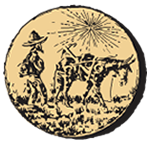Mining and Minerals Education Foundation |

Hugh Exton McKinstry
(1896-1961)
2006 Inductee from Mining's Past
Hugh Exton McKinstry was born in West Chester, Pennsylvania, on May 5, 1896. He graduated from Haverford College in 1917 and went to France to do relief work with the American Red Cross. He entered the Massachusetts Institute of Technology where, under the influence of Waldemar Lindgren, he earned a Master's Degree in 1921. During the next three years, he was employed by Cerro de Pasco and devoted his work to the study of ores in the Andes under the influence of Donald H. McLaughlin, Chief Geologist of Cerro de Pasco. He returned to school at Harvard University, where he was a part-time instructor under Professor L. C. Graton, and was awarded a doctor's degree from Harvard in 1926.
The next twenty years of McKinstry's career were characterized by worldwide travel and a variety of studies that included ores of South Africa, Australia, and Canada. He carried out many evaluations of mining properties and in 1933, joined Case, Pomeroy and Co. in New York. He became an independent consultant in New York in 1937. These years of travel and study of a great spectrum of ore deposits and deposit styles established an unequaled background of understanding of ore deposits during a time of expansion of the mining industry in the Americas. This prepared him for teaching, the career in which he spent the rest of his life. Shortly after McKinstry started teaching at the University of Wisconsin, the nation became involved in the Second World War and he entered government service. He first served as Chief of the Minor Ferro-Alloys Division of the Board of Economic Warfare (1942-1944) and later as Chief of the Minerals Division of the Foreign Economic Administration (1944-1945). Following the war, he returned to his first love, teaching, this time at Harvard. He subsequently served as president of the Society of Economic Geologists and was a fellow of the American Academy of Arts and Sciences.
The knowledge of ores that McKinstry assimilated from the unparalleled growth of the industry, coupled with his extensive background in the field study of ores, formed the background for his textbook, Mining Geology that became, and remains, a touchstone of practical knowledge on the practice of mining geology at both exploration and operation levels. This book, together with a generation of Harvard students, many of whom ultimately became teachers, stands as McKinstry's monumental contribution to the study, interpretation, and discovery of ore deposits.
